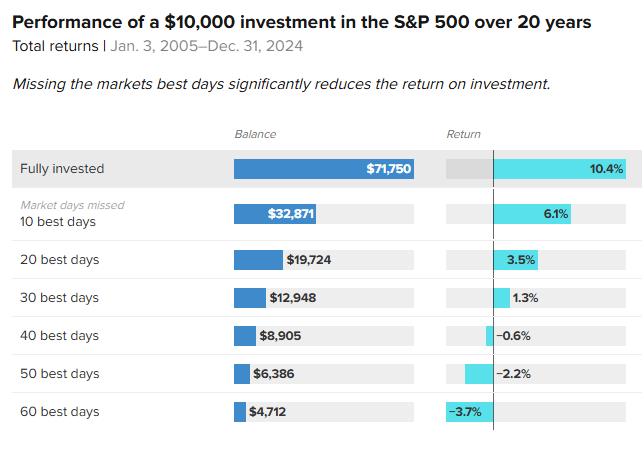Quarterly Outlook
Equity outlook: The high cost of global fragmentation for US portfolios
Charu Chanana
Chief Investment Strategist
Chief Investment Strategist
It finally happened. After weeks of relentless red screens and investor nerves stretched thin, Wall Street got a major jolt of relief—and it was a big one. The Nasdaq surged 12% in a single day. The S&P 500 rallied nearly 10%. Even the battered Dow saw a 7.9% comeback.
Tech was the undisputed leader, with Nvidia up 19%, Tesla popping 23%, and Apple adding 15% in a flash. The rally followed a surprise policy move by President Trump, who announced a 90-day pause on the harshest new tariffs—for countries that hadn’t retaliated against the U.S. Investors had been bracing for a deeper economic hit from escalating trade tensions, so the temporary truce sparked a massive wave of buying.
But beyond the headlines, yesterday’s rally sent a powerful message: this is why staying invested matters.
Market timing sounds good in theory. In reality? It’s incredibly hard to do. Selling during downturns can protect capital in the moment, but it risks missing the exact days that drive long-term returns.
Historically, just a handful of the market’s best days each year account for the lion’s share of long-term returns. Miss them, and you could drastically undercut your portfolio’s performance.
Let’s say you sold earlier this week to “wait out the volatility.” It’s totally understandable—but it would’ve meant sitting out one of the strongest one-day rallies in history.
Yes, the news was significant. But the bigger story is what this kind of day tells us about investing: you need to be in the market to benefit from days like this.
The JP Morgan chart below shows the steep cost of missing just a few key days—even over a 20-year horizon.

Source: JP Morgan Asset Management
Many of those "best days" come right after the worst. Just like Wednesday.
The market has been under pressure for weeks as tariffs between the U.S. and China escalated. Tech, in particular, took it on the chin. But Wednesday’s surge showed just how quickly sentiment can shift. Investors didn’t need all the uncertainty to go away—they just needed a little less bad news.
And here’s the kicker: Trump also announced a steep 125% tariff on China the same day. So yes, risks remain, and this rally may prove short-lived.
But markets looked past the negatives and seized on any hint of progress. That’s how bottoms often form: quietly, amid a fog of bad news, and when few expect it.
Trade tensions are still high, inflation risks remain, and the Fed isn’t in a rush to cut rates.
But if you’re investing with a multi-year lens, this week was your reminder: staying calm, consistent, and committed matters more than ever. You don’t need to time the bottom—you just need to be there when it happens.
Consider these strategies:
Disclaimer
The Saxo Bank Group entities each provide execution-only service and access to Analysis permitting a person to view and/or use content available on or via the website. This content is not intended to and does not change or expand on the execution-only service. Such access and use are at all times subject to (i) The Terms of Use; (ii) Full Disclaimer; (iii) The Risk Warning; (iv) the Rules of Engagement and (v) Notices applying to Saxo News & Research and/or its content in addition (where relevant) to the terms governing the use of hyperlinks on the website of a member of the Saxo Bank Group by which access to Saxo News & Research is gained. Such content is therefore provided as no more than information. In particular no advice is intended to be provided or to be relied on as provided nor endorsed by any Saxo Bank Group entity; nor is it to be construed as solicitation or an incentive provided to subscribe for or sell or purchase any financial instrument. All trading or investments you make must be pursuant to your own unprompted and informed self-directed decision. As such no Saxo Bank Group entity will have or be liable for any losses that you may sustain as a result of any investment decision made in reliance on information which is available on Saxo News & Research or as a result of the use of the Saxo News & Research. Orders given and trades effected are deemed intended to be given or effected for the account of the customer with the Saxo Bank Group entity operating in the jurisdiction in which the customer resides and/or with whom the customer opened and maintains his/her trading account. Saxo News & Research does not contain (and should not be construed as containing) financial, investment, tax or trading advice or advice of any sort offered, recommended or endorsed by Saxo Bank Group and should not be construed as a record of our trading prices, or as an offer, incentive or solicitation for the subscription, sale or purchase in any financial instrument. To the extent that any content is construed as investment research, you must note and accept that the content was not intended to and has not been prepared in accordance with legal requirements designed to promote the independence of investment research and as such, would be considered as a marketing communication under relevant laws.
Please read our disclaimers:
- Notification on Non-Independent Investment Research (https://www.home.saxo/legal/niird/notification)
- Full disclaimer (https://www.home.saxo/en-gb/legal/disclaimer/saxo-disclaimer)